This week the discussion of the Rabbis Freedman is about the Golden Calf and its aftermath.
You can subscribe directly to the YouTube channel here: https://www.youtube.com/channel/UCnamNZsuUWMC-oBbV4XB7Hg
This week the discussion of the Rabbis Freedman is about the Golden Calf and its aftermath.
You can subscribe directly to the YouTube channel here: https://www.youtube.com/channel/UCnamNZsuUWMC-oBbV4XB7Hg
A new video series featuring, Rabbi Freedman, Rabbi Freedman, and Rabbi Freedman! You can subscribe directly to the YouTube channel here: https://www.youtube.com/channel/UCnamNZsuUWMC-oBbV4XB7Hg
This week’s discussion is about the skills that the Jews needed to build the Tabernacle – the portable Temple that they carried with them throughout their 40 year journey in the desert.
Click here for a printable PDF of this article.
Matzah clearly plays a central role in the Passover holiday. On Seder night, there is a specific mitzvah to eat matzah. In addition, the Torah prohibits the consumption of 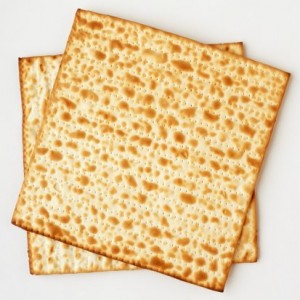 chametz, the antithesis of matzah, for all eight days of Passover. What do matzah and chametz symbolize, and why are they so central to our celebration of Passover?
chametz, the antithesis of matzah, for all eight days of Passover. What do matzah and chametz symbolize, and why are they so central to our celebration of Passover?
Rabbi Samson Raphael Hirsch (1808 – 1888; Frankfurt, Germany), explains that as we know, matzah is bread that is made from dough that was not given time to rise. This type of bread would generally be eaten by one who is pressed for time. As a matter of fact, the Talmud nicknames matzah, lechem oni – poor man’s bread. A poor man is always in a flurry trying to survive and therefore has no time to allow his dough to rise. Throughout our slavery in Egypt, our Egyptian masters did not allow us the time needed for our dough to rise. Hence, we usually ended up eating matzah. Upon our long awaited departure from Egypt, we still ate matzah, as the Egyptians were driving us out, again not giving our dough time to rise.[1] Matzah, therefore, symbolizes servitude. Chametz, on the other hand, is the bread of one who is his own master. He can allot however much time he desires to make sure his bread rises appropriately. Chametz symbolizes independence. Continue reading Passover – Matzah: Celebrating our Dependence on God
Click here for a printable PDF of this article.
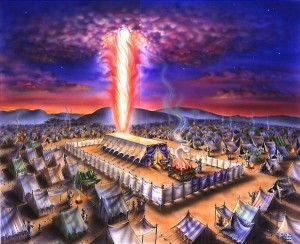 We have spent the past few weeks following the conversation between God and Moses as to how to build the Tabernacle, its vessels, and the priestly clothing. This week, the Torah tells us that Moses appointed Betzalel to lead the building project. Throughout the parshah, as the Torah describes the actual construction of the Tabernacle, it continually states, “such and such was done as God commanded Moses.” Why, while discussing the topic of the Tabernacle, does the Torah stress that everything was done, “as God commanded Moses,” more than any other part of the Torah? Continue reading Parshat Pekudei – Our Moral Compass
We have spent the past few weeks following the conversation between God and Moses as to how to build the Tabernacle, its vessels, and the priestly clothing. This week, the Torah tells us that Moses appointed Betzalel to lead the building project. Throughout the parshah, as the Torah describes the actual construction of the Tabernacle, it continually states, “such and such was done as God commanded Moses.” Why, while discussing the topic of the Tabernacle, does the Torah stress that everything was done, “as God commanded Moses,” more than any other part of the Torah? Continue reading Parshat Pekudei – Our Moral Compass
Click here to download a printable PDF of this article.
In reading through the verses describing the aron, the Ark, we find a running theme of duality. The Ark was comprised of a box made from cedar wood, sandwiched between and inner and outer gold box –  two layers of gold. There were two cherubs attached to the cover of the Ark. There were two tablets placed within the Ark. What is the meaning of this theme?
two layers of gold. There were two cherubs attached to the cover of the Ark. There were two tablets placed within the Ark. What is the meaning of this theme?
Throughout Jewish writings, the Ark clearly is symbolic of the Torah. The lesson of the duality is that Torah observance requires joining with others. Judaism is not meant to be practiced in isolation. We are supposed to be part of a community. Continue reading Parshat Terumah – The Duality of the Ark
Click here to download a printable PDF of this article.
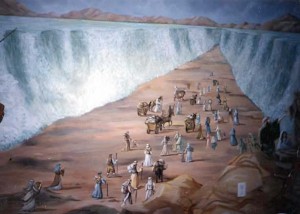 The very first conversion to Judaism takes place in this week’s parshah. The Torah relates that Yitro (Jethro), the father-in-law of Moses, traveled from Midyan to join the Jewish people. The Talmud explains that there were two events that prompted him to convert. The first catalyst was hearing of the miraculous splitting of the Yam Suf, the Red Sea. The second was hearing about the war with the nation of Amalek that took place at the end of last week’s parshah.
The very first conversion to Judaism takes place in this week’s parshah. The Torah relates that Yitro (Jethro), the father-in-law of Moses, traveled from Midyan to join the Jewish people. The Talmud explains that there were two events that prompted him to convert. The first catalyst was hearing of the miraculous splitting of the Yam Suf, the Red Sea. The second was hearing about the war with the nation of Amalek that took place at the end of last week’s parshah.
It is understandable that the account of the escape of the Jews from the pursuing Egyptians through the splitting of the Red Sea would aid in one’s decision to join the Jewish people. Why, however, would hearing about the war with Amalek convince Yitro that he should convert to Judaism? If the Talmud would identify the miraculous Jewish victory over Amalek that occurred at that time as the impetus, it would be understandable; however, the Talmud states clearly that it was the war itself, not the victory, which was the second catalyst. Continue reading Parshat Yitro – Catalyst for Conversion
Click here for a printable PDF of this article.
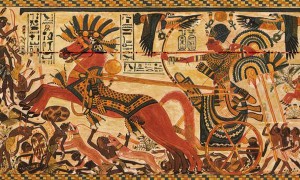 Only five days after the Jewish people were dramatically emancipated from the cruel Egyptian slavery, Pharaoh had a sudden change of heart and regretted sending the Jews away. Intending to force them to return and to subjugate them to slavery once more, he gathered his men and chased after the nascent nation. Having tasted a mere five days of freedom, the Jewish people found an Egyptian army bearing down upon them and almost overtaking them.
Only five days after the Jewish people were dramatically emancipated from the cruel Egyptian slavery, Pharaoh had a sudden change of heart and regretted sending the Jews away. Intending to force them to return and to subjugate them to slavery once more, he gathered his men and chased after the nascent nation. Having tasted a mere five days of freedom, the Jewish people found an Egyptian army bearing down upon them and almost overtaking them.
The Torah, in describing how the unified, single-minded, and focused army was bearing down upon and overtaking the Jews, seems to use erroneous grammar. It states that “Egypt nasayah (journeyed, singular form) after them,” as opposed to, “the Egyptians nasa’u (journeyed, plural form) after them.” Why this apparently mistaken verbiage? Continue reading Parshat Beshalach – Unity Regardless of Commonality
Click here for a printable PDF of this article.
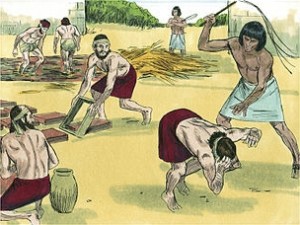
We find ourselves at the climax of the past number of parshiyot. Over the past few weeks, we read about God’s promise to give the Jewish people the Land of Canaan, the rivalry between Joseph and his brothers that brought the entire family to Egypt, and the ensuing slavery that the Jews endured under Pharaoh’s cruel rule. We are holding at the turning point in the story. The background narrative of the Jewish heroes, Moses and Aaron, has been developed. 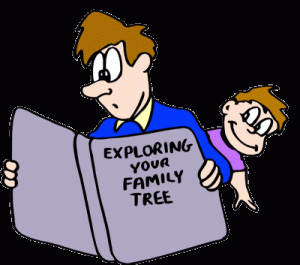 The highpoint of the redemption is about to begin. But wait! The Torah interrupts the story just as the narrative is reaching its climax with seemingly mundane, unrelated details: the genealogy of Moses and Aaron. Why interrupt the storyline at its most suspenseful moment with this unnecessary information? Continue reading Parshat Va’eira – Striving for Greatness
The highpoint of the redemption is about to begin. But wait! The Torah interrupts the story just as the narrative is reaching its climax with seemingly mundane, unrelated details: the genealogy of Moses and Aaron. Why interrupt the storyline at its most suspenseful moment with this unnecessary information? Continue reading Parshat Va’eira – Striving for Greatness
Click here for a printable PDF of this article.
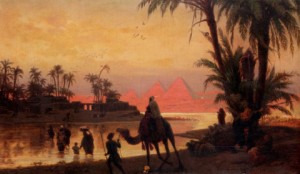 Pharaoh’s astrologers informed him that a boy would be born who would redeem the Jewish people from Egyptian slavery. He therefore enacted a new decree that all male newborns would be drowned in the Nile River. At this point in the story, the Torah tells us that ‘A man went from the house of Levi and married a daughter of Levi.’ This man was Amram. The ‘daughter of Levi’ was Jochebed.
Pharaoh’s astrologers informed him that a boy would be born who would redeem the Jewish people from Egyptian slavery. He therefore enacted a new decree that all male newborns would be drowned in the Nile River. At this point in the story, the Torah tells us that ‘A man went from the house of Levi and married a daughter of Levi.’ This man was Amram. The ‘daughter of Levi’ was Jochebed.
The Talmud details the interesting background to this marriage. Amram and Jochebed were previously married. In fact, they already had two children, Miriam and Aaron. When Pharaoh legislated this new barbaric decree of killing every newborn male child, Amram decided that it was not worthwhile to continue having children; after all, if a boy would be born,  Pharaoh’s henchmen would find and kill the baby. He therefore divorced his wife. As Amram was the leader of the Jewish people at the time, all the rest of the Jews followed suit and divorced their wives. Miriam, who at the time was a mere six years old, understood the situation and recognized the obvious outcome of her father’s decision: no more Jewish children. Disagreeing with her father, she presented him with the following three arguments as to why he should stay married:
Pharaoh’s henchmen would find and kill the baby. He therefore divorced his wife. As Amram was the leader of the Jewish people at the time, all the rest of the Jews followed suit and divorced their wives. Miriam, who at the time was a mere six years old, understood the situation and recognized the obvious outcome of her father’s decision: no more Jewish children. Disagreeing with her father, she presented him with the following three arguments as to why he should stay married:
I always treasure every moment I am able to spend with my revered grandfather, Rabbi Hirsch Diskind. No matter what the situation is, he always has a unique outlook and a life lesson to teach.
I once went shopping with him, and when we were leaving the store, someone opened the door to come in. Since the door closed slowly, there would be enough time for us to walk through the open doorway before the door closed. As we passed by the fellow that had actually pushed the door open, my grandfather thanked him for opening it for us. Noticing that I myself hadn’t thanked that person, my grandfather took the opportunity to discuss with me the importance of hakarat hatov – appreciating the good that is performed for you. In order to get me thinking, he challenged me to pinpoint the Torah source for thanking Continue reading Parshat Va’eira – Appreciating Appreciation